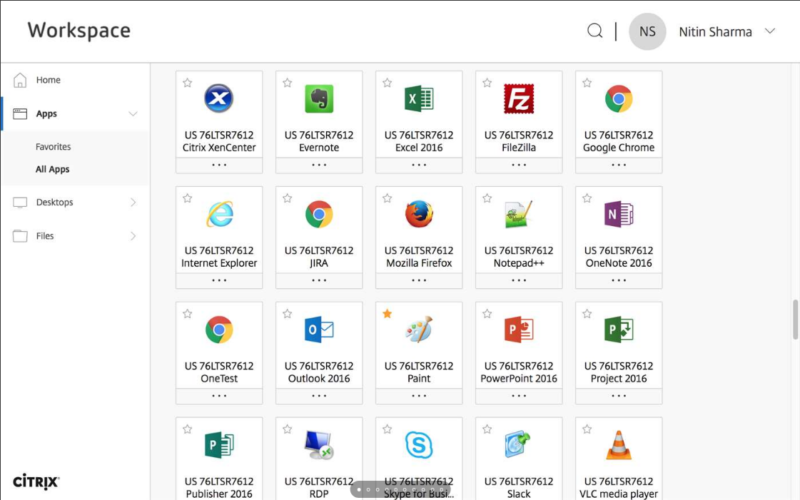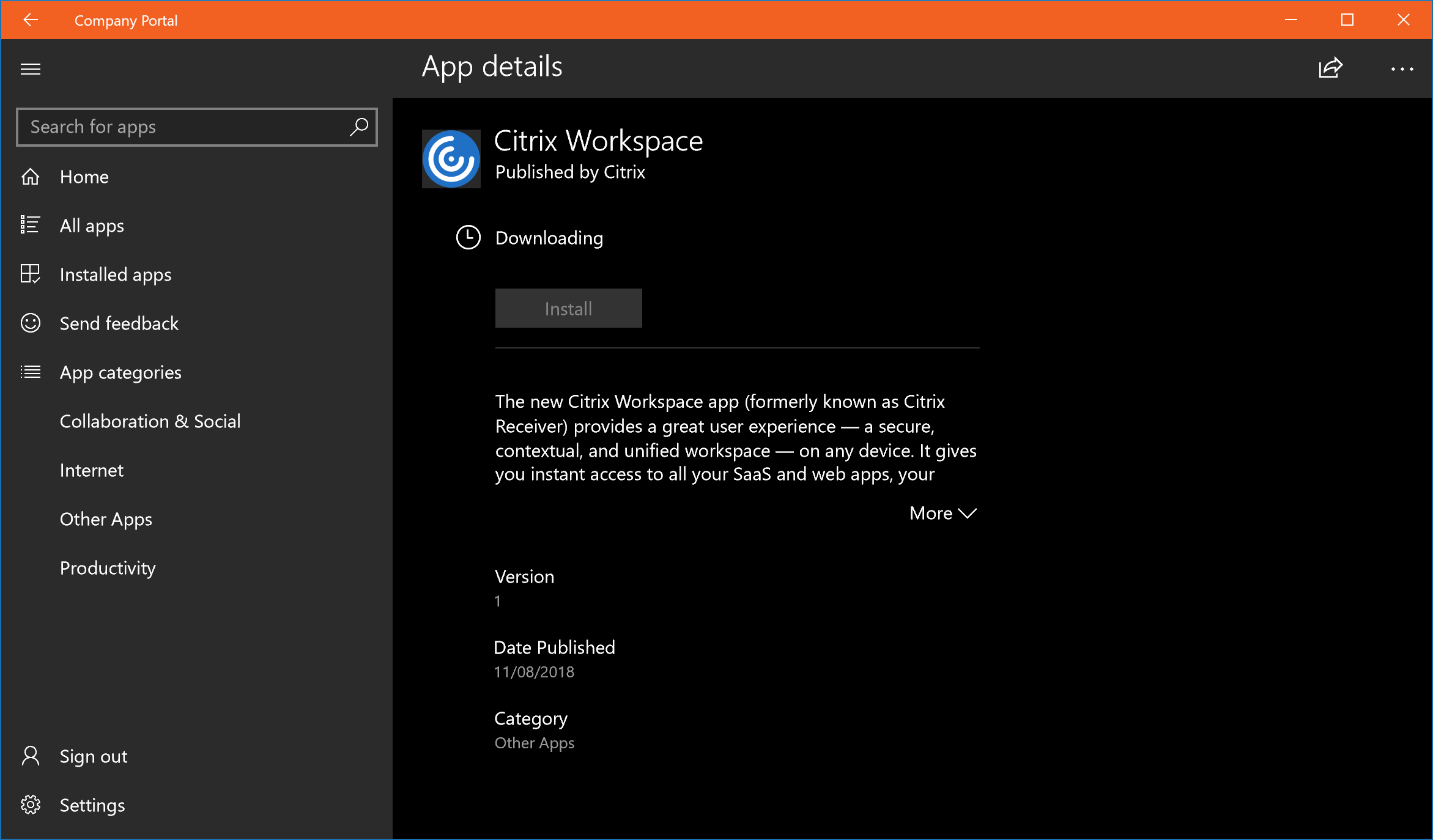Depending on the Receiver package installed, delete one of the following keys in MicrosoftWindowsCurrentVersionUninstall if they exist: CitrixOnlinePluginFull; CitrixOnlinePluginPackWeb; After uninstalling the Receiver software, any custom Receiver-side registry keys that icaclient.adm created remain in the registry as well. How can we manage Workspace App settings on a remote Windows device using MDM/Intune? Obviously default store is the most crucial but also other settings? I have ADMX ingestion working with Intune and can deploy settings, but while deploying the Storefront list does populate the clients registry.
•Citrix Receiver is being replaced by the new Citrix Workplace. Citrix Workspace has the same functionality as Receiver, but with more capabilities, and is backward compatible with all Citrix solutions.
•The following topic is for clients who are already running EventPro in Citrix Receiver, and need to switch to the new Citrix Workspace for Desktop or/and Mobile. (If you are installing Citrix for the first time, you can begin at Install Citrix.)
•In many cases, you will not need to uninstall your existing Citrix Receiver before installing Citrix Workspace. However, Citrix has noted that some versions will need to be removed manually before you can install Citrix Workspace.
1.To upgrade to Citrix Workspace for Desktop, go to https://www.citrix.co.in/downloads/workspace-app.
Download and install the app for your operating system.
2.During installation, Citrix Workspace should automatically replace your existing Citrix Receiver.
You will notice that the Citrix desktop icon turns from black to blue, the color of the new Workplace app.
3.When you run Citrix Workspace for the first time, you will receive this dialog:
a.The Learn More button will direct you to a website with more information about Citrix Workspace.
b.Click Got It to go to the Citrix Workspace app.
4.Citrix Workplace should remember your Account and go directly to the login dialog.
However, if you need to add your Account again, review Run Citrix Workspace & Add Account.
5.When Citrix Workspace opens, you can log in as usual.

6.Once logged in, your EventPro app should still be there, as before. If not, you can review how to Add Apps to Citrix Workspace. You can now run EventPro, and continue to work as usual.
7.The process of upgrading to Citrix Workspace on your smartphone or tablet will vary, depending on your device, its operating system, and its settings.
a.Typically, you can update or install the Citrix Workspaceapp from the iTunes App Store (Apple iOS devices) or Google Play (Android devices), but if neither of those options are applicable to you, there are other versions available for download on the Citrix website.
b.If your device is set to automatically install app updates, Citrix Receiver may have already been upgraded automatically for you.
c.When you run Citrix Workspace on your mobile device for the first time, you may get a notification that Citrix Receiver has been upgraded to Citrix Workspace.


d.If your account and favorite apps have not been preserved during the upgrade, you can review how to Add an Account, Log In/Sign In, Add Apps to Favorites, Adjust Settings, and more under EventPro Cloud on Mobile Device.
Copyright Profit Systems Inc. EventPro Software is a wholly owned subsidiary of Profit Systems Inc.
Dealing with Citrix ADMX files can be confusing. But there is hope on the horizon. It looks like Citrix finally got it under control.
The issue
Citrix Workspace Replace Receiver Download
The implementation of Citrix ADMX files has been a bit chaotic so far. Remember this view? A tad bit messy I would say.
Your central ADMX repository contained the following five Citrix ADMX files:
- ctxprofile5.x.0.admx
- ica-file-signing.admx
- HdxFlash-Client.admx
- receiver.admx
- receiver_usb.admx
These files were clearly not in sync with one another.
The solution
It seems that Citrix also realized that the above structure was not the way to go, so they implemented something new.
You now only need three ADMX files (+ corresponding language files of course):
- ctxprofile5.6.0.admx
- CitrixBase.admx*
- receiver.admx**
*This file is new. It only has one purpose, which is to define the shared 'Citrix Components' folder in the Group Policy editor.
**This file belong to Citrix Receiver 4.6
The following ADMX files have now been merged in the new 'receiver.admx' file:
- HdxFlash-Client.admx
- ica-file-signing.admx
- receiver_usb.admx
There is more than one way how to get these new ADMX files:
Citrix Downloads Workspace App Windows

- Citrix Receiver - CitrixBase.admx and receiver.admx:
- Download the ADMX files as a stand-alone package in the section Download for Admins (Deployment Tools): Receiver 4.6 for Windows
- Download and install Receiver and than copy the files from the Citrix Receiver installation directory: C:Program Files (x86)CitrixICA ClientConfiguration
- Citrix User Profile Manager - CitrixBase.admx and ctxprofile5.6.0.admx:
- Download the software User Profile Manager 5.6 in the section Components that are on the product ISO but also packaged separately.
Extract the ZIP file:- The ADMX file for the User Profile Manager is located in the directory:
Group Policy Templatesen - The ADMX file CitrixBase is located in the following directory:
Group Policy TemplatesCitrixBase
- The ADMX file for the User Profile Manager is located in the directory:
- Download the XenDesktop 7.12 ISO file in the section Product ISO.
Extract the ISO file:- The ADMX file for the User Profile Manager is located in the directory:
x64ProfileManagementADM_Templates - The ADMX file CitrixBase is located in the following directory:
x64ProfileManagementADM_TemplatesCitrixBase
- The ADMX file for the User Profile Manager is located in the directory:
- Download the software User Profile Manager 5.6 in the section Components that are on the product ISO but also packaged separately.
| Update (16.02.2017): In XenDesktop 7.12 the new CitrixBase.admx is also available for Citrix FAS (Federated Authentication Service). To get the ADMX files you have to first install the FAS component. By default, the ADMX and ADML files are located in the directory C:Program FilesCitrixFederated Authentication ServicePolicyDefinitions. Please see the article Citrix Federated Authentication Service (SAML) written by Carl Stalhood on how to install and configure FAS. As far as I can tell the latest version of Citrix Sharefile does not include the unified CitrixBase.admx file yet. There is a 'base ADMX' file for ShareFile itself though; the file ShareFile.admx. The ADMX files ShareFileDriveMapper.admx and ShareFileSync.admx both use the ShareFile.admx base file. The ADMX files for ShareFile On-Demand Sync for XenApp and Desktop and ShareFile Sync for Windows are identical and can be downloaded here and here. The ADMX file for ShareFile Drive Mapper can be downloaded here. The ADMX file Citrix Workspace Environment Management Agent Host Configuration v4.0.admx for Citrix Workspace Environment Management also does not yet support the CitrixBase.admx file. The file name does contain a nice typo though (Citrix Worskpace Environment). To get the ADMX files, download and extract the ZIP file containing the installation sources. The ADMX and ADML files are located in the subdirectory Configuration ADM - ADMX. Update (21.02.2017): |
The remainder of this paragraph explains how to update the central ADMX repository in your domain.
- Central ADMX repository:
%LogonServer%sysvol#DomainName#PoliciesPolicyDefinitions - Central ADMX repository for the language files:
%LogonServer%sysvol#DomainName#PoliciesPolicyDefinitions#language-country#
- Delete the old Citrix ADMX language files (= *.ADML) from the repository:
- ctxprofile5.x.0.adml (replace the 'x' for the correct version)
- ica-file-signing.adml
- HdxFlash-Client.adml
- receiver.adml
- receiver_usb.adml
- Delete the old Citrix ADMX files from the repository:
- ctxprofile5.x.0.admx (replace the 'x' for the correct version)
- ica-file-signing.admx
- HdxFlash-Client.admx
- receiver.admx
- receiver_usb.admx
- Copy the new Citrix ADMX language files (= *.ADML) to the repository:
- ctxprofile5.6.0.adml
- CitrixBase.adml
- receiver.adml
- Copy the new Citrix ADMX files to the repository:
- ctxprofile5.6.0.admx
- CitrixBase.admx
- receiver.admx
And now you are done. If you would like to test the ADMX files before updating the central ADMX repository you can use the local ADMX repository on a server:
- Copy the ADML and ADMX files to the local ADMX repository (C:WindowsPolicyDefinitions)
- Open the local group policy console go to Start, Run and enter the command gpedit.msc. You will now see the new ADMX files.
Note: your group policy settings are NOT affected when you update ADMX files. Your settings are stored in different files within the group policy:
- Registry.pol -> contains group policy settings
- *.xml (e.g. Files.xml) contains your group policy preference settings
- Policies.gpf -> contains the settings of your Citrix policy (NOT the once based on an ADMX file)
The path to your group policy is as follows:
%LogonServer%sysvol#DomainName#Policies#PolicyGUID#
The result
Citrix Storefront Receiver Workspace
The group policy console now looks like this:
Citrix Workspace App Replace Receiver
Most items are now stored under Citrix Components, except for the Workspace Environment Management and ShareFile policies. Still, it is quite an improvement I would say.
I am happy with the progress Citrix made. But since I am a bit of a stickler, I still see room for improvement. For example, the name of the ADMX file should always start with 'Citrix' in my opinion. This makes it a lot easier to identify all Citrix-related ADMX files in the central repository. Also, the first letter of the ADMX file should start with a capital letter, but now I am nitpicking.

Citrix Workspace Replace Receiver Lock
